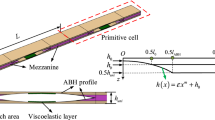Abstract
The Sonic Black Holes (SBH) absorber consists a cylindrical cavity with a set of rigid thin rings. The inner diameters of the rings are gradually decreasing. The sound speed in SBH can be progressively slowed down, then the effective sound absorption performance can be obtained. In order to further improve the acoustic performance of the SBH, the sponges are used as sound-absorbing material in SBH. The sponges of 2 mm thickness are arranged at the bottom and the different ranges of the inner wall of the SBH. The absorption coefficients of the SBH before and after the sponge arrangement are experimentally investigated. The experimental results reveal that the SBH structure is different from the traditional vibration-based acoustic black hole (ABH) structure. The sound absorption performance cannot be improved effectively when the sponge is placed at the bottom of the SBH. However, when the sponge is placed on the inner wall around the bottom of the SBH, the sound absorption performance can be improved markedly.
Access this chapter
Tax calculation will be finalised at checkout
Purchases are for personal use only
Similar content being viewed by others
References
Mironov, M.A.: Propagation of a flexural wave in a plate whose thickness decreases smoothly to zero in a finite interval. Soviet Phys. Acoust. 34(3), 318–319 (1988)
Krylov, V.V.: Conditions for validity of the geometrical-acoustics approximation in application to waves in an acute-angle solid wedge. Soviet Phys. Acoust. 35, 176–180 (1989)
Huang, W., et al.: Energy focusing effect of two-dimensional acoustic black hole on flexural waves. J. Vib. Shock 36(09), 51–57+92 (2017)
Gao, N.S., et al.: Progress and applications of acoustic black holes. Sci. Bull. 67(12), 1203–1213 (2022)
Krylov, V.V., Tilman, F.J.B.S.: Acoustic ‘black holes’ for flexural waves as effective vibration dampers. J. Sound Vib. 274, 605–619 (2004)
Bowyer, E.P., et al.: Effect of geometrical and material imperfections on dam** flexural vibrations in plates with attached wedges of power law profile. Appl. Acoust. 73, 514–523 (2012)
Kralovic, V., Krylov, V.: Dam** of flexural vibrations in tapered rods of power-law profile: experimental studies. Appl. Acoust. 76, 359–365 (2014)
Mironov, M.A., Pislyakov, V.V.: One-dimensional acoustic waves in retarding structures with propagation velocity tending to zero. Acoust. Phys. 48(3), 347–352 (2002)
Mi, Y.Z., et al.: Wave trap** by acoustic black hole: simultaneous reduction of sound reflection and transmission. Appl. Phys. Lett. 118(11), 114101 (2021)
Umnova, O., et al.: Multiple resonances in lossy acoustic black holes-theory and experiment. J. Sound Vib. 543, 117377 (2023)
Červenka, M., Bednařík, M.: On the role of resonance and thermoviscous losses in an implementation of ‘“acoustic black hole”’ for sound absorption in air. Wave Motion 114, 103039 (2022)
Mousavi, A., Berggren, M., Wadbro, E.: How the waveguide acoustic black hole works: a study of possible dam** mechanisms. Acoust. Soc. Am. 151(6), 4279–4290 (2022)
Guasch, O., Arnela, M., Sánchez-Martín, P.: Transfer matrices to characterize linear and quadratic acoustic black holes in duct terminations. J. Sound Vib. 395, 65–79 (2017)
Ouahabi, A.A.E., Krylov, V.V., O’Boy, D.: Experimental investigation of the acoustic black hole for sound absorption in air. In: The 22nd International Congress on Sound and Vibration, Florence (2015)
Acknowledgement
We would like to express our gratitude to the funding support from the National Natural Science Foundation of China (No. 12364058 and No. 51975266) and the Aeronautical Science Foundation of China (No. 2020Z073056001).
Author information
Authors and Affiliations
Corresponding author
Editor information
Editors and Affiliations
Rights and permissions
Copyright information
© 2024 Chinese Society of Aeronautics and Astronautics
About this paper
Cite this paper
Peng, L., Mao, Q. (2024). Experimental Investigation of Sound Absorption Properties of the Damped Sonic Black Holes. In: Proceedings of the 6th China Aeronautical Science and Technology Conference. CASTC 2023. Lecture Notes in Mechanical Engineering. Springer, Singapore. https://doi.org/10.1007/978-981-99-8861-7_28
Download citation
DOI: https://doi.org/10.1007/978-981-99-8861-7_28
Published:
Publisher Name: Springer, Singapore
Print ISBN: 978-981-99-8860-0
Online ISBN: 978-981-99-8861-7
eBook Packages: EngineeringEngineering (R0)




